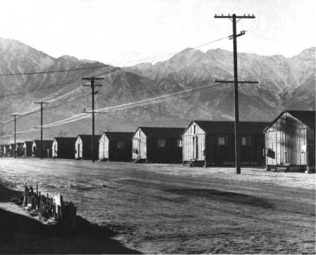Manzanar Project
Housing:

Internees in Manzanar lived in barracks like those above. The barracks were made out of very cheap materials such as tar paper roofs with holes in it that led in dust and incests. They slept on army cots.
The residential area was about one square mile and consisted of 36 blocks of hastily constructed, 20-foot by 100-foot tar paper barracks, with each internee family living in a single 20-foot by 25-foot “apartment” in the barracks. These apartments consisted of partitions with no ceilings and no privacy.
Each residential block also had a communal mess hall, a laundry room, a recreation hall, an ironing room, and a heating oil storage tank. In addition to the residential blocks, Manzanar had 34 additional blocks that had staff housing, camp administration offices, two warehouses, a garage, a camp hospital, and 24 firebreaks. The camp also had school facilities, a high school auditorium, chicken and hog farms, churches, a cemetery, a post office, a cooperative store, other shops, and a camp newspaper.
The residential area was about one square mile and consisted of 36 blocks of hastily constructed, 20-foot by 100-foot tar paper barracks, with each internee family living in a single 20-foot by 25-foot “apartment” in the barracks. These apartments consisted of partitions with no ceilings and no privacy.
Each residential block also had a communal mess hall, a laundry room, a recreation hall, an ironing room, and a heating oil storage tank. In addition to the residential blocks, Manzanar had 34 additional blocks that had staff housing, camp administration offices, two warehouses, a garage, a camp hospital, and 24 firebreaks. The camp also had school facilities, a high school auditorium, chicken and hog farms, churches, a cemetery, a post office, a cooperative store, other shops, and a camp newspaper.
Latrines:
The latrines in the camp were communal with no partitions and the showers had no stalls. Internees in Manzanar didn't like the latrines because they had no privacy. Many of the Japanese-American citizens had to sneak in during the night because of the low privacy. Most latrines were overflowed or broken, causing more problems for the Japanese-American citizens. If you were an internee in Manzanar and you ran to a latrine, you better hope that it was working.
